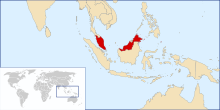|
Sultan Azlan Shah Airport
Sultan Azlan Shah Airport (IATA: IPH, ICAO: WMKI) is an airport serving the city of Ipoh in the Malaysian state of Perak. Situated approximately 6 kilometres (3.7 mi) from the city center, it ranks as the 15th busiest airport in Malaysia.[3] HistoryHistory and InceptionIpoh Airport was originally planned to be developed in 1983 under the Fourth Malaysia Plan.[4] During that period, the airport could only accommodate smaller aircraft such as the Fokker models.[5][5] In response to rising air travel demand, a new terminal was proposed in late 1988, with an allocated budget of RM35 million.[6] This expansion included runway extensions to support larger Boeing 737 aircraft.[6] The construction of these improvements was completed in August 1989, with the terminal expected to be operational by mid-September of that year.[6][5] Decline in Passenger DemandDuring its peak, Ipoh Airport served a significant number of passengers, partly due to Malaysia Airlines operating services to and from the city. However, following the opening of the North-South Expressway, many travelers opted for alternative transportation methods, which offered more cost-effective options compared to air travel. Consequently, Malaysia Airlines and later AirAsia ceased their services from the airport. Additionally, with the introduction of electric train services that provided direct links to Kuala Lumpur, Malaysia Airports began to re-evaluate the financial sustainability of Ipoh Airport.[7] Revitalisation and UpgradesTo revitalise the airport, a new terminal building was constructed along with an extended runway at a cost of RM45 million. The runway was lengthened to 2,000 metres (6,600 ft) to allow operations by larger aircraft such as the Boeing 737 and Airbus A320 families. The new terminal featured expanded departure and arrival halls, full air-conditioning and an increased capacity to handle a larger volume of passengers.[8] Despite these upgrades, the runway was initially restricted to turboprop aircraft due to the emergence of potholes shortly after construction.[9] Although the issue was resolved, similar runway maintenance issues recurred before being permanently addressed, allowing the runway to be used daily by various aircraft.[10][11] Recent Services and OperationsIn September 2014, Firefly resumed operations at Ipoh Airport with a route to Singapore, followed by Malindo Air (now Batik Air Malaysia) in October 2014, which introduced routes to Subang, Johor Bahru and Medan, Indonesia. Srivijaya Air also launched a route to Medan in November 2014, expanding the airport’s connectivity within the region. In May 2015, Tigerair, now Scoot, began services to Ipoh, further enhancing its international reach. AirAsia resumed its Johor Bahru-Ipoh service in October 2018 and added a new routes to Singapore in December 2018 and Langkawi in 2020. These additions strengthened Ipoh Airport’s position as a growing regional airport, offering more options for both domestic and international travel. Future Growth and Expansion PlansThe Malaysian Government has explored relocation options for Ipoh Airport, constrained by surrounding residential areas that limit further expansion. Potential sites considered include areas farther from the city center, such as Seri Iskandar or Batang Padang near Tapah, though no concrete actions have been implemented. Another proposal suggested utilizing Ipoh as a feeder airport, as it faces challenges competing with larger airports in Penang and Kuala Lumpur. While several airlines have expressed interest in adding routes to Ipoh, only Tigerair (now Scoot) has established operations.[12] Airlines from China and Indonesia have also indicated interest in future services.[13] In March 2017, the Perak state government announced plans to expand the terminal to increase passenger capacity. Additional upgrades, including an extension of the runway from 2 to 2.5 kilometres (1.2 to 1.6 mi), were anticipated the following year to better support larger aircraft and enhance connectivity. These improvements are aimed at making Ipoh Airport more competitive as a regional hub while addressing the space limitations of its current location. Airlines and destinations Passenger
Traffic and statistics
References
External links
|
|||||||||||||||||||||||||||||||||||||||||||||||||||||||||||||||||||||||||||||||||||||||||||||||||||||||||||||||||||||||||||||||||||||||||||||||||||||||||||||||||||||||||||||||||||||||||||||||||||||||||||||||||||||||||||||||||||||||||||||||







